While visiting a friend’s new BTO at the end of last year, I was quite enamoured by the hot/ cold water dispenser system that he had. One touch of a button, and nearly ice-cold water, or (very) hot water came flowing out. Best of all, it connected directly to the water inlet and so there wasn’t a need to refill a water tank every now and then.
There was also a lack of this ‘tap water taste’, which, upon some cursory research, I realised was primarily due to the chlorine content in tap water. Although tap water in Singapore is perfectly drinkable, I typically boil my water beforehand which helps to remove that taste. Thus, for my upcoming BTO, I decided to get one of these magical water dispenser/ purifier systems to save me the trouble of having to boil water every single day, and be able to enjoy near ice-cold water without having to put a jug in the fridge.
Upon doing my research on such water dispenser/ purifier systems, I ended up with more questions than answers. The only thing definitive about such systems was a video CNA published on water filters and how, in most cases, the water ended up being dirtier than water dispensed directly from the tap. Other than that, you have to sift through questionable marketing material and influencers who may or may not have a vested interest in the products which they are endorsing. At the end of the day, unless one were to collect samples from each brand at the same source and send it to a water lab for testing, it would be very difficult to substantiate each manufacturer’s claim with regard to filtration quality and cleanliness.
That said, I had to make a decision and so, I went down to the showrooms of Sterra, Wells, Livingcare and Hydroflux to take a look at the water purifying systems on display and see which system best fits my needs. While cleanliness and filtration quality is a consideration, I also considered other more practical aspects such as the maintenance required, quality, taste and temperature of the water and the dispensing capacity. While my research was primarily for myself to make a more informed decision, I thought that I would share some of my findings over here as well.
For the purpose of this comparison, I had a look at the Sterra S, Wells tt UV+, Wells The One, Livingcare Jewel and the Hydroflux Wish. I also had a look at the older Hydroflux H2300 which I will mention in passing below. I did not look at the Cosmo Quantum or the Ruhens V. For the latter, I did not consider it in my decision matrix because in terms of functionality, it appears to be similar to the Hydroflux H2300.
At a Glance
| Description | Sterra S | Wells tt UV+ | Wells The One | Livingcare Jewel | Hydroflux Wish |
|---|---|---|---|---|---|
| Dimensions (WxDxH) (mm) | 182x509x403 | 190x495x430 | 88x88x337 countertop; 180x480x470 under cabinet | 130x390x320 | 168x465x450 |
| Price with 7% GST (base group buy/ maximum group buy) | 1,499 (min. 8 pax) 1,399 (min. 20 pax) | 2,471.70 (min. 1 pax) 2,171.70 (min. 71 pax) | 3,595.20 (min. 1 pax) 3,295.20 (min. 71 pax) | 2,448.16 (min. 2 pax) 2,127.16 (min. 100 pax) | 2,876.16 (before price revision in May 2022) 2,983.16 (min. 1 pax, after price revision) 2,769.16 (min. 61 pax) |
| Number of years of filter provided | 2 years | 3 years (4 years with min. 11 pax under group buy) | 3 years (4 years with min. 11 pax under group buy) | 4 years | 4 years |
| Warranty | 1 year whole machine, 3 years for touch panel and water leakage (upgradeable to lifetime upon posting of photo review) | 3 years (full) | 3 years (full) | 3 years (full) | 1 year for heating element, compressor and speaker; 4 years on-site for general wear and tear services (extendable with purchase of additional filter set); 1 free relocation |
| Filter quality | 4-stage (pre-carbon block, UF and post carbon block) | 9-stage (sediment, carbon block, remove heavy metal, anti-bacteria, minerals, sediment, positive charge membrane, post-carbon, silica ball) | 9-stage (sediment, carbon block, remove heavy metal, anti-bacteria, minerals, sediment, positive charge membrane, post-carbon, silica ball) | Nano-positive and carbon block | 6-in-1 nano-filter (remove rust, bacteria, super bacteria and norovirus), remineralisation |
| Sterilisation features | UV sterilisation at nozzle, auto discharge, electrolysis sterilisation of inner pipes | UV sterilisation at nozzle. Supposedly has ‘even cleaner water’ with patented technology that eliminates the need for hidden cooling tanks | Anti-bacteria cartridge at nozzle, auto discharge, electrolysing cleansing of pipes | Internal auto cleaning/ discharge, UV sterilisation at nozzle | Auto discharge, heat pasteurisation |
| Maintenance considerations | Replace two filters every 4 months and 8 months (self-replaceable) | Replace filter every year. Self-replaceable but you will need to unscrew the back panel to access. However, free installation of filters is provided. Optional descaling and sterilising service available at an additional $60. Recommended to be done once a year or every two years. | Replace filter every year. Self-replaceable but not easily accessible. However, free installation of filters is provided. | Self-replaceable filter (once a year) | Self-replaceable filter (once a year) |
| Filter cost | 299 (2 years) 499 (4 years) | 330 (1 year) | 380 (1 year) | 240 (1 year) | 280 (1 year, non-alkaline) 300 (1 year, alkaline) |
| Temperature settings (°C) | 4, 25, 40, 87 | 6, 27, 50, 70, 85 | 6, 27, 36.5, 50, 70, 85 | 7 – 17, room, 40-90 | 4, 25, 40, 75, 90 |
| Capacity settings (ml) | 120, 250, 550, continuous | 120, 250, 550, continuous | 120, 250, 550, continuous | 110, 250, 500, continuous | 120, 550, 1000 |
| Pipe material | Stainless steel cooling pipe (per website) Stainless steel hot water pipe (claimed by sales rep) | Stainless steel cooling pipe (per website) Stainless steel hot water pipe (claimed by sales rep) | “Super bio water pipe” (mix of glass and PVC) with water repellent material | LDPE plastic | Full stainless steel |
| Faucet material | ABS plastic | ABS plastic | ABS plastic | ABS plastic | Stainless steel |
| Unique selling points | Value-for-money, retractable nozzle | Patented cooling technology with ‘true tankless’ design allowing for more supply of cold water at once, adjustable height for nozzle to reduce splashing | Smallest above-counter unit, stylish design, anti-bacterial cartridge at nozzle | Motorless design (i.e., no compressor and energy saving), slimmest countertop-only design, filter cleaning function to extend filter life, practical dispensing capacity options (e.g. 250ml, 500ml) | Full stainless steel flow path (from inner pipes to faucet), adjustable height for nozzle to reduce splashing, Bluetooth speaker, front accessible filter, pasteurisation sterilisation feature, relatively fast cold water dispensing speed |
| Cons | No nano-filtration feature, OEM product, no 500ml dispensing option | Harder to change water filter, no inner pipe sterilisation feature, no 500ml dispensing option | Harder to change water filter, big water filtration unit below, no UV sterilisation, no 500ml dispensing option | No inner pipe sterilisation feature, high water wastage due to motorless design, cold water is not very cold | No UV sterilisation feature, alkaline filter requires additional intermediate piping, no 500ml or continuous dispensing options |
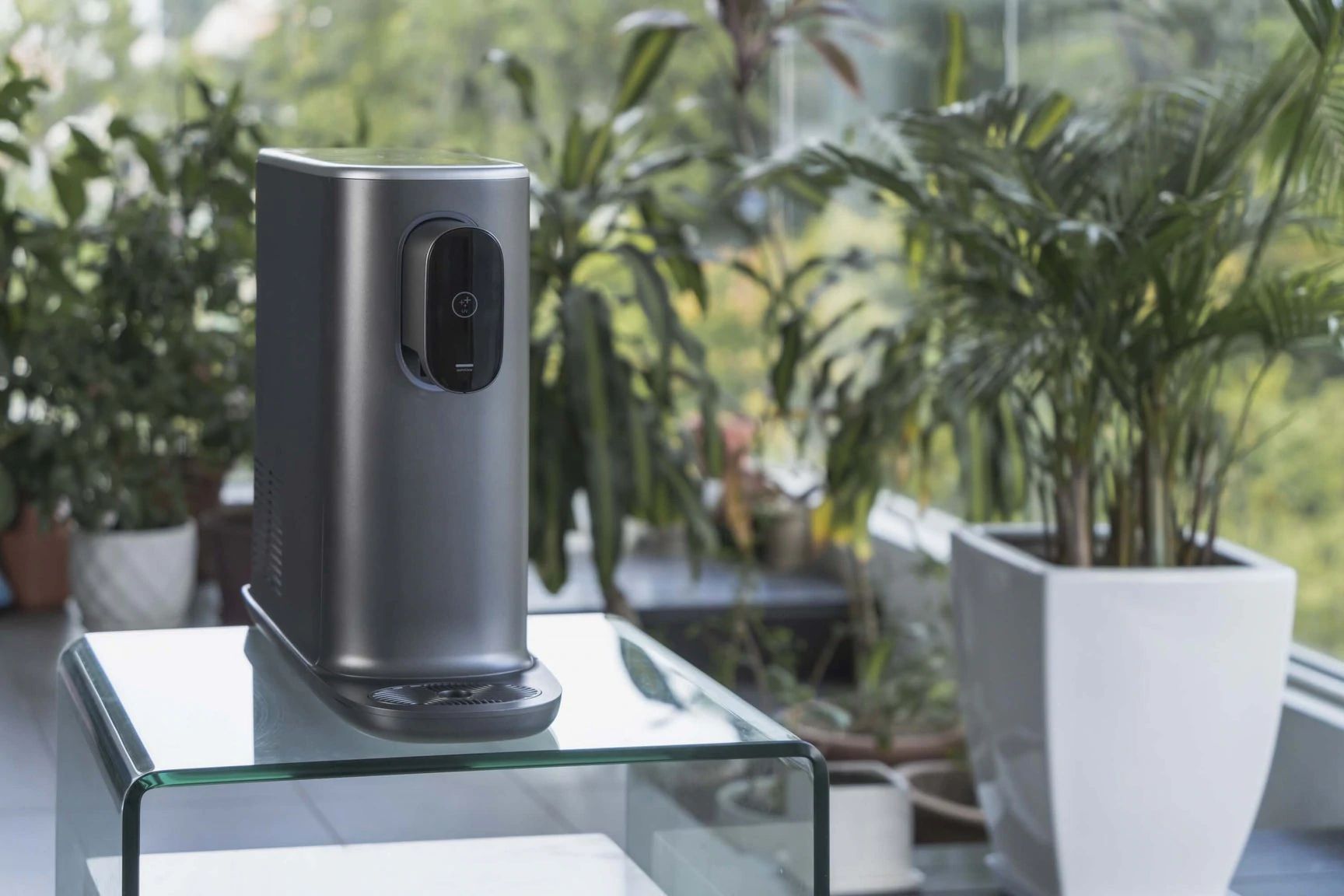
Sterra S
Launched just last year (the company itself was just incorporated in 2021), Sterra has, within a span of a couple of months, become a household name (at least for those in the market for a water purifier) perhaps in part due to its marketing prowess. Compared to the other brands on this list, Sterra seems to be the most savvy in terms of social media outreach and reaching out to influencers and celebrities. Customers are also incentivised to leave photo reviews so as to extend the warranty for the touch panel and water leakage to lifetime. While on one hand, it’s good to have a large pool of user reviews from which to draw inferences from, on the other hand, the reviews may be biased or unhelpful (like those reviews on Qoo10, Shopee or Lazada where people leave 5-star reviews but claim not to have tested or used the product yet).
Now, let’s talk about the product itself. The Sterra S is essentially a rebranded Ovio OHC-7000D, which another brand in Singapore, Purikool, also carries. Unfortunately for Purikool, Sterra’s marketing game is a couple of notches higher and hence, you don’t really hear much about the Puri Jiksoo. In terms of features, the Sterra S compares well against its competitors, though it falls short in terms of filtration quality as its filters only offer microfiltration instead of nanofiltration. That said, that level of filtration is probably not required in Singapore’s context, and I guess it would be technically possible for Sterra to introduce new compatible filters with nanofiltration capability down the road. Sterra also does not offer an alkaline option (if you care for it).
According to competing sales reps, given that the Sterra S is an OEM (shorthand for original equipment manufacturer) product, there is a possibility that someone may buy over the exclusive rights to the product in future and you may lose the option to buy replacement filters or seek repairs in future. While that’s a valid consideration, I have my doubts as to whether this issue would even surface over the lifetime of the product.
On the flip side, being an OEM product means that you can easily find the user manual online where you can learn more about the technical characteristics of the product. From the user manual, you would note that the Sterra S is not a “true tankless” product, in that it has a “chilling tank” which needs to be chilled at all times to dispense cold water instantly. It also means that if you dispense a large quantity of cold water at once, the temperature may increase over time.
The Sterra S requires both a water inlet and water outlet. The water outlet serves to reduce the build up of stagnant water by flushing the pipes every now and then and also after changing the filter (to prevent fine carbon particles from leaking into the water). While some may argue that having a water outlet function would waste more water, I think if the purpose is to sterilise the internal pipes, that’s an acceptable trade-off.
My first interaction with the Sterra S was at a friend’s house. The cold water was definitely cold enough, though I did not try the other temperature options. The water dispensing speed was reasonable. The water tasted fine. I had the same experience at Sterra’s showroom as well. However, one point which I had some reservations about was the vent slits at the side of the dispenser, which are relatively big in size and clearly expose the circuit board on the inside. You may wish to position the Sterra S slightly away from the sink to avoid accidental splashes.
Dispensing capacity options are 120ml, 250ml, 550ml and continuous. I am somewhat puzzled by the inclusion of a 550ml capacity option, because my Nalgene bottles are only 500ml. Looks like you’ll have to press 250ml twice or dispense 550ml with some overflow (or rush to stop it before it does so).
At its price point (especially if you can secure the maximum group buy discount), the Sterra S is a really attractive product and probably the option to consider for most. If you’re keen on getting the Sterra S, you may wish to watch this informative YouTube review, where the reviewer actually measures several practical aspects suhc as the dispensing speeds and temperatures.
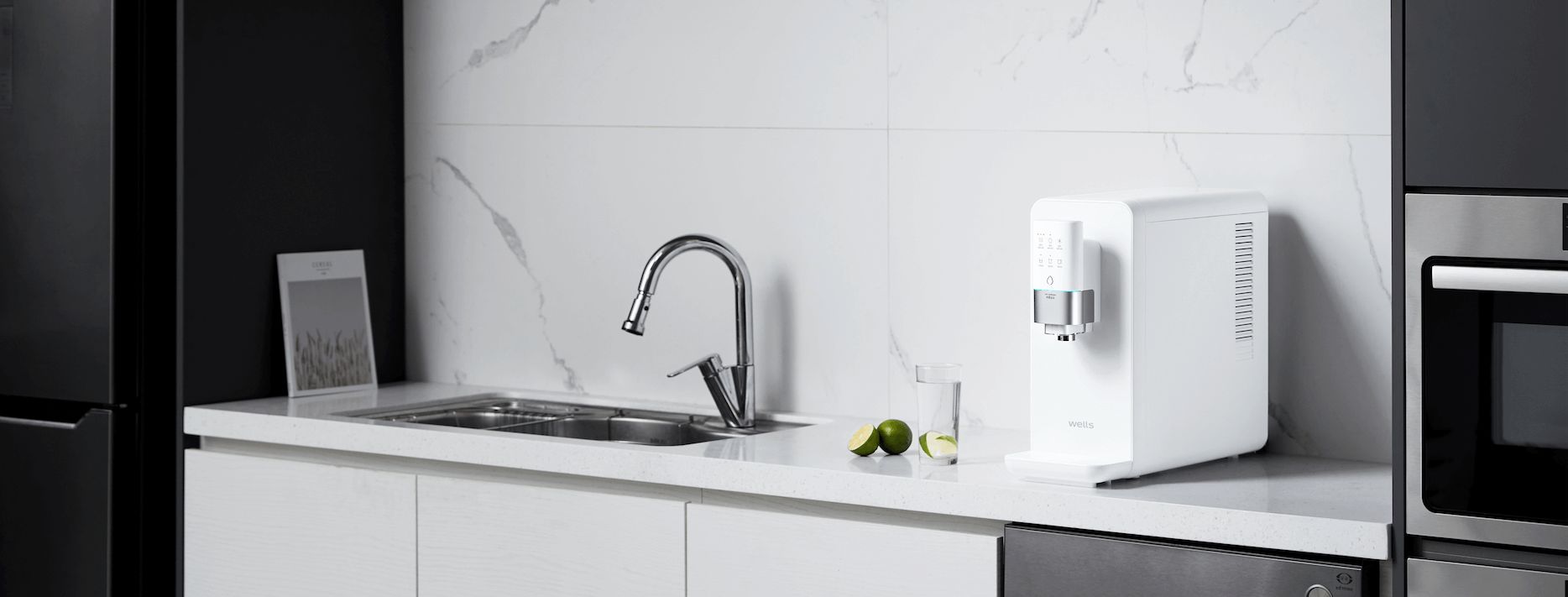
Wells tt UV+
Wells Singapore is also quite a recent entrant to the Singapore market (though, more well established than Sterra). A quick search on the Singapore holding company’s name (MyLifestyle Holdings Pte. Ltd.) shows that the company was incorporated in 2016.
The products which Wells Singapore brings in are from Kyowon Wells, part of the Kyowon group, an “educational life culture company” which apparently also operates tuition centres and hotels in Korea. Kyowon Wells itself was established in 2003, making it one of the more established brands in the market. According to Kyowon Wells’ website, Wells Singapore is listed as an “overseas partner” of Kyowon Wells.
Launched in October 2020 in Korea, the Wells tt UV+ builds upon the earlier Wells tt with an additional UV nozzle sterilisation option. According to its marketing materials, the Wells tt and the Wells tt UV+ are the only “truly tankless” designs in the market, where, instead of a “cooling tank”, it uses some dual piping cooling pipe mechanism to cool the water instead, thus resulting in lower power consumption, a lower risk of external contamination, and potentially limitless amount of cold water that can be dispensed.
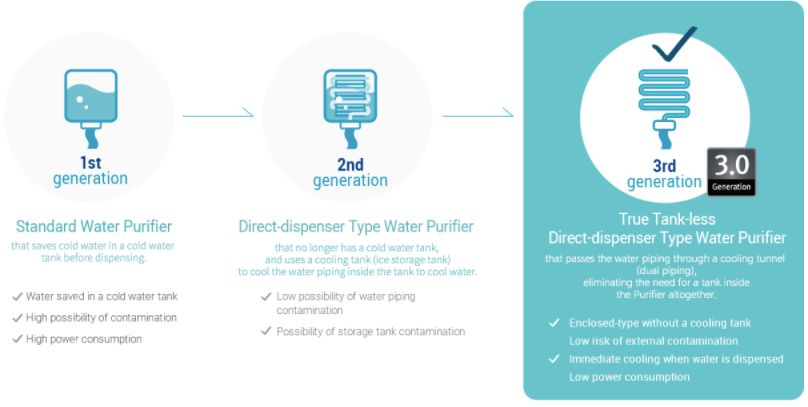
I tested the practical aspects of the Wells tt UV+ quite extensively at the Wells showroom as this was the product I was most interested in (and eventually settled upon, for full disclosure). While the first bit of cold water dispensed was not ice-cold, it got colder over time, and even after dispensing 500ml of water at once, the resultant water was still pretty cold. I was concerned that the temperature of the hot water would not be hot enough (given that it tops out at 85 degrees Celsius compared to 87 to 90 degrees Celsius in the other options), the resultant water was still hot enough to scald my tongue.
In terms of water dispensing speed, the cold water dispensing speed was acceptably fast. Meanwhile, hot water dispensed a little bit more slowly, and unfortunately, with a little bit of droplets splashing out of the styrofoam cup (even after adjusting the height of the nozzle). Perhaps with a larger cup you’ll experience less splashing, but this is something to bear in mind. At least there’s a child lock function which can be easily activated by pressing and holding a particular button (I can’t remember which), which would lock out the hot water function. The water had no taste to it.
After testing the system quite extensively (I think I used like about a litre or so of water), I noticed some small black particles in the water. I was told that this was due to the carbon filter and was ‘normal’. I guess this could be a result of the filter not being “flushed” properly beforehand, or a filter that’s too old?
The Wells sales rep claimed that its filters are the best in the market. I have no way of proving it, of course, so I’ll just take it with a (generous) pinch of salt. Wells offers both alkaline and non-alkaline filter options. I think the water I tasted from had an alkaline filter, though I did not notice any taste.
Compared to other competing brands, it’s a little harder to replace the filter on the Wells tt UV+. You apparently have to unscrew the back panel, and then disconnect the filter tubes accordingly (unlike, say, the Livingcare Jewel where you can just twist and turn the filter out) and vice versa when installing the new filter. You also have to flush the system yourself after installing the new filters (as there is no outlet pipe on the Wells tt UV+), although there is a system function that will help you flush the system.
The reason why the filter replacement is more convoluted is probably because in Korea, the Wells water purifiers are sold “as a service”, that is, the water purifiers are leased out rather than sold. In Korea, a Wells technician will come down every three months to perform a sterilising spray service, every six months to perform a descaling kit sterilisation service, and every twelve months to replace the nozzle tip.
While that level of service is not available in Singapore, what I understood from the sales rep was that the Wells technician will come down every year to install the filter (filters are only made available on request, even if purchased in advance, as they apparently have expiry dates) for you, free-of-charge. You can also opt for the descaling kit sterilisation service, which costs an additional $60, although I was told that this was optional and not really required in Singapore’s context.
I was also a little apprehensive about the fact that the Wells tt UV+ does not come with a water outlet and whether this would cause issues in the long run or result in the system being less clean (since there is no flow path sterilisation feature like on the Sterra, Wells The One and the Hydroflux Wish). In the end, I reasoned with myself that I could probably do a self-discharge on my own or just pay the extra $60 for the descaling sterilisation as and when the need arises.
The Wells tt UV+ also comes with an ABS plastic faucet (as with every other dispenser, apparently, except the Hydroflux Wish), which I was (and still am) a little apprehensive about, given that the dispenser would also be used to dispense hot water. In addition, while the tt UV+ advertises itself as having “full stainless steel cooling pipes”, nothing is said about the hot water pipes, although the sales rep reassured me that it would also be stainless steel. That said, given that I’ve not seen a full cross-section view of the dispenser, I still wonder if this is correct (if it were stainless steel, then it should have been advertised as such, right?). But given that nearly all other water dispensers on the market (except the Hydroflux Wish) do not advertise themselves as having a stainless steel hot water pipe, I decided to just bite the bullet and trust that whatever material is used is safe for water consumption (microplastics are everywhere, anyway…).
Overall, I think the Wells tt UV+ is a good mix of price, features and filtration quality. While it isn’t the best at any one aspect, it’s quite a well rounded machine and the option which I decided to go for in the end.
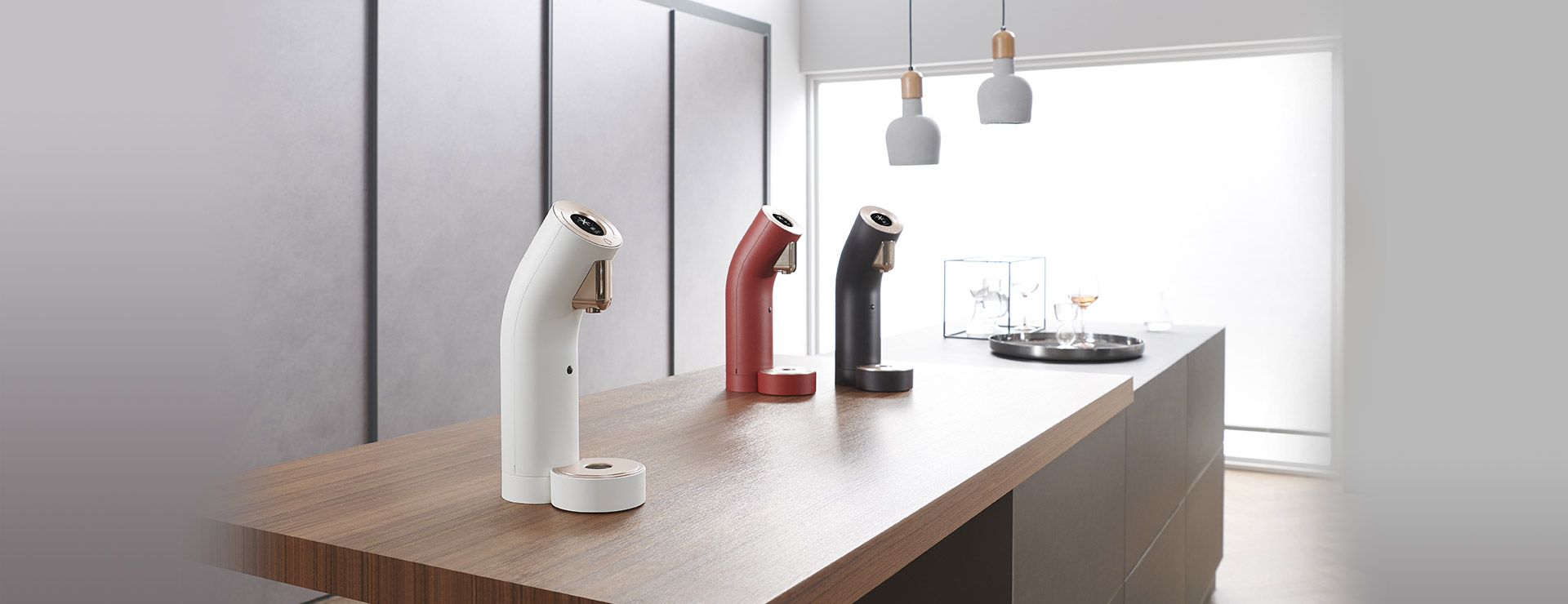
Wells The One
“The One” is probably, as the name suggests, the water dispenser that everyone thinks about when you mention “Wells”. It’s probably the only water dispenser on the market that looks just right on a kitchen island (for the rest, you’ll have to figure out how to hide the inlet/ outlet pipes from the back), and takes up very little real estate on your countertop. You can swivel the unit by 180 degrees, making it more easily accessible from either side of your kitchen island.
Compared to the Sterra S, Wells tt UV+ and Livingcare Jewel, dispensing water probably takes a couple more steps because you’ll have to fiddle with the touch wheel to select the correct option (and also a potential point of failure).
The issue with The One is that it has a huge filtration unit that will need to sit below your counter. The size of that filtration unit itself is already the same size or even larger than a comparable tankless water dispenser. It also requires a comparatively large hole that needs to be drilled in your countertop — so you have to consider the future implications if you were to replace this water dispenser with something else down the road.
Unlike the Wells tt UV+, The One advertises itself as using “super bio water pipes”, which, as I understand from the sales rep, is a mixture of glass and PVC. I’m not too sure how much I would trust this to dispense hot water though I was assured that it would not cause plastics leaching into the water (I guess, perhaps its a PVC exterior with inner glass lining?) and that it was ‘more expensive’ than stainless steel.
Curiously, The One does not advertise itself as having true tankless technology and I guess it would therefore be reasonable to conclude that it still relies on a chilling tank (like the Sterra and Hydroflux Wish).
I did not really test this system much at the showroom (actually, I was a bit disappointed that it couldn’t swivel a full 360 degrees!), although a quick test of the cold water dispensing feature showed that its water temperature is comparable to that of the Wells tt UV+. Dispensing speed of cold and hot water seemed a little bit slower compared to the Wells tt UV+. Taste wise, it was identical to the tt UV+.
If you’re looking for something stylish and would fit right at home in the middle of a kitchen island, the Wells The One is probably the option to go for. That said, it is incredibly pricey, and for that price (plus the sacrifice you’ll have to make by drilling a large hole in your countertop), 3 years of warranty does seem a tad too few.
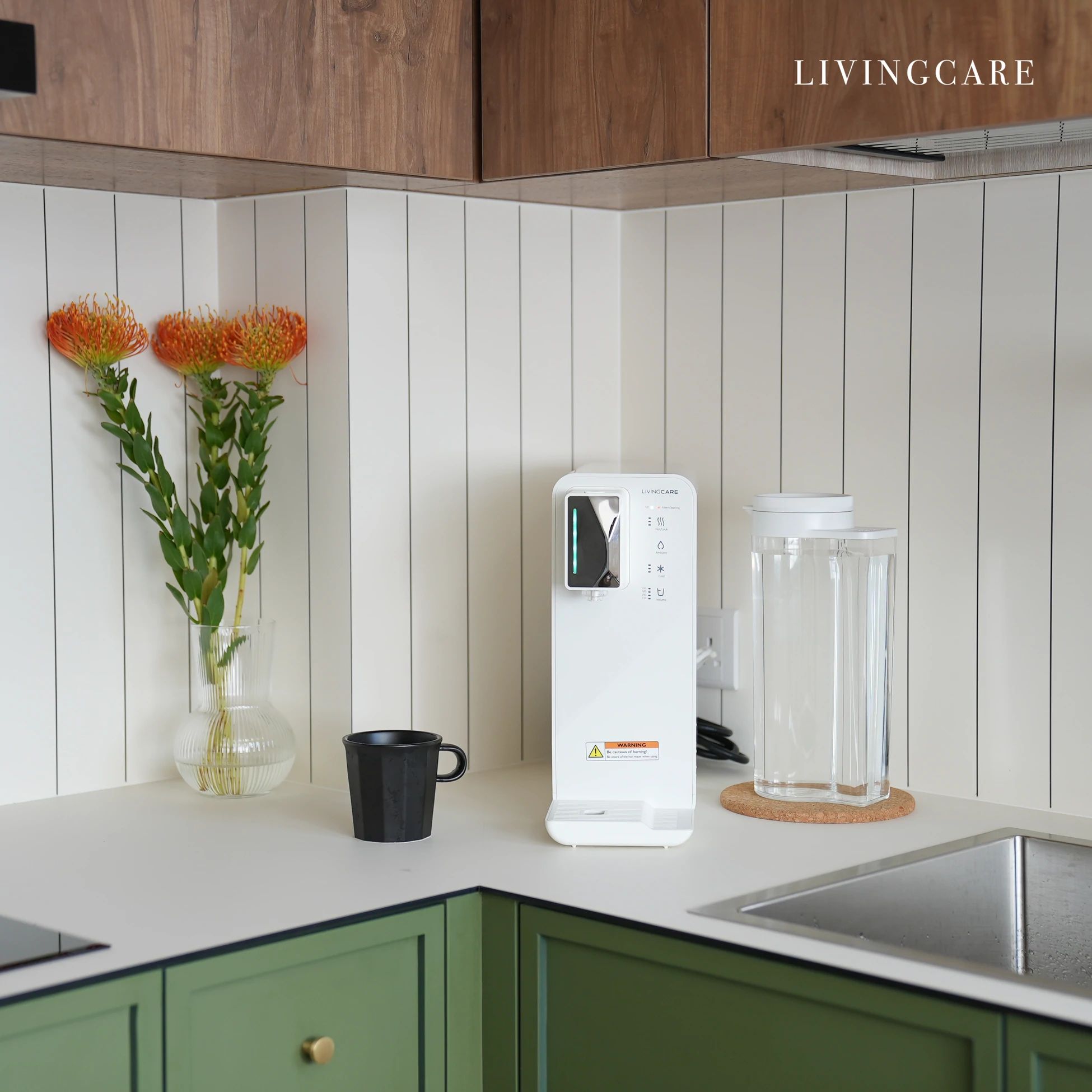
Livingcare Jewel
The Jewel advertises itself as a motorless unit. What this means is that it does not rely on a compressor to chill water, but instead, probably relies on thermoelectric cooling. If you head down to Livingcare’s showroom in Ang Mo Kio, they have a demonstration unit with a transparent side panel so you can see everything that’s going on inside. The lack of a compressor also means that they’re able to make this unit one of the smallest countertop units in the market (bar The One).
The pipes in the Livingcare Jewel are fashioned out of LDPE, a type of plastic which, according to the sales rep, can withstand temperatures up to 130 degrees Celsius (that being said, a quick search on Wikipedia shows that it can only withstand temperatures of up to 65 degrees Celsius continuously and 90 degrees Celsius for short period of time). At least they are open about the materials used.
What they are not so open about (at least in marketing materials), is that the temperature of the cold water that it dispenses is not very cold at all. Within the same showroom, I was able to try the Jewel side-by-side with the Hydroflux Wish, and the Wish was much noticeably colder. In comparison, even at the maximum cool setting, the cold water temperature of the Jewel felt similar to water left in an air-conditioned room for a period of time (in other words, cool but not cold) and is definitely warmer than the 7 degrees Celsius advertised. It also dispenses a lot of water just to dispense a cup of cold water. In a competitor’s showroom which I visited, they actually had a Livingcare Jewel unit, which they used to demonstrate how much water it uses. To dispense a cup of cold water, you’d notice that about two cups of water will first flow through the system and to the outlet pipe, before the cold water is dispensed into your cup. If you’re looking to get a water dispenser primarily for fridge-cold water, you’re better off looking elsewhere.
That said, the Livingcare Jewel makes up for its shortcomings (somewhat) through its practical functionality. It offers water dispensing capacities of 110ml, 250ml, 500ml and 1,000ml. Short of a 1.5L bottle, it covers pretty much most cup and bottle sizes. In addition to room temperature, there are also three cold water and three hot water temperature options to choose from, making it quite versatile if you are looking for a specific temperature range. It also has a unique filter cleansing feature, which is apparently able to extend the life of your filters. Design wise, it’s also one of the more attractive options with several pastel colour options available in addition to black or white. Taste wise, it tastes about the same as the rest, i.e. tasteless.
The Livingcare YouTube channel is quite active and provides quite a lot of information (relatively speaking, of course) on the use of the product, so you may want to check that out if you’re interested in the Jewel.
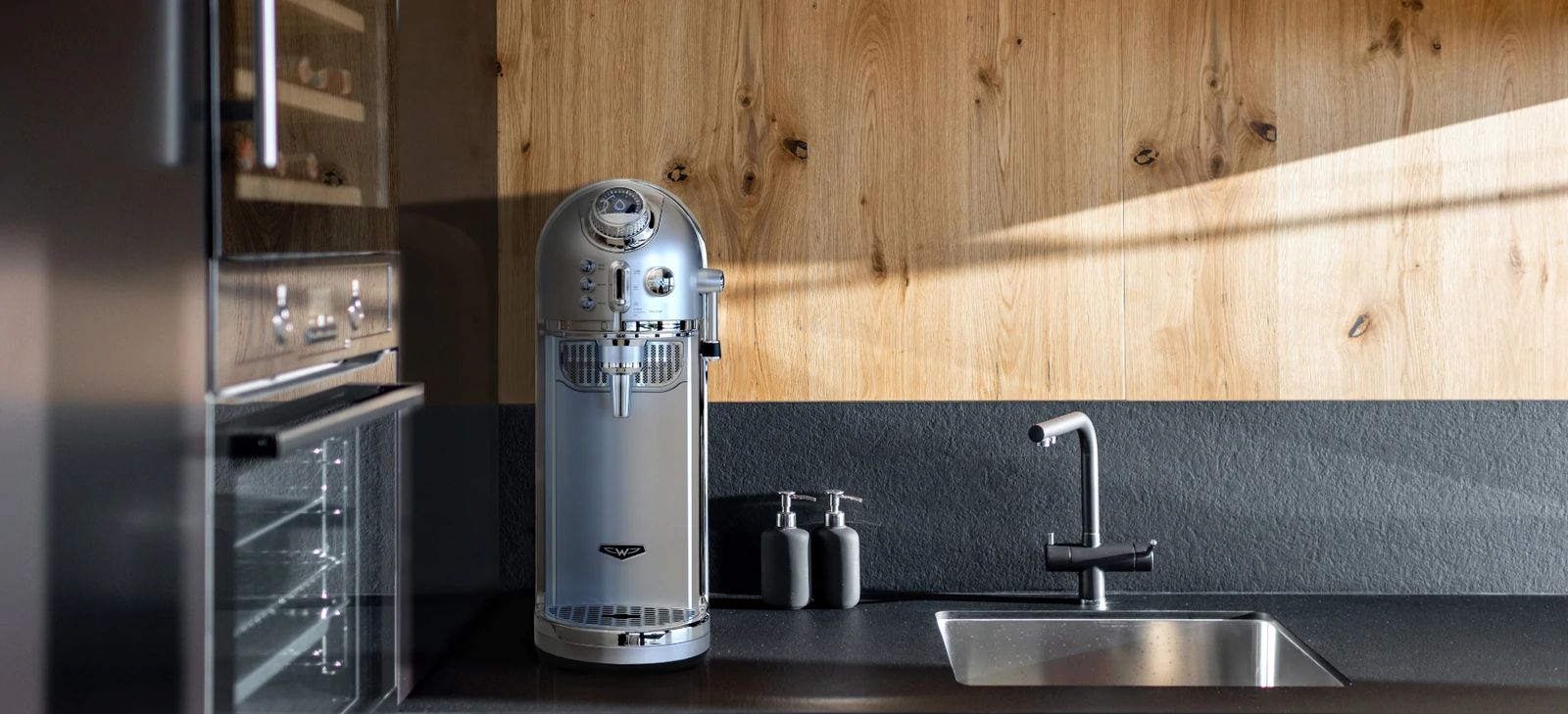
Hydroflux Wish
Last but not least, we look at the Hydroflux Wish. Unfortunate name aside (maybe they were trying to capitalise on Hyflux’s brand name in the past?), Hydroflux is one of the more established brands here in Singapore.
The Hydroflux Wish has quite a polarising design that you either love or hate. While I personally like the design, my SO feels otherwise. I guess it might just fit in place if you’re planning to place it next to your silver oven, or next to a coffee machine. It has kind of a retro feel to it, and it relies on tactile design elements such as push buttons, a rotary dial, and a capacity slider which I thought was a very nice touch. It’s taller than all the other machines on this list, so you
Doing a bit of digging (and reverse image search), the Wish was originally developed by a company called Bodyfriend in Korea, and the original name was the “W Water Purifier Brain” (thank goodness they didn’t retain the name)! Upon clarification with the sales rep, apparently Hydroflux bought over the rights to the said water purifier and that is why the said water purifier is no longer available for sale on Bodyfriend’s website.
Among all the water dispensers in this list, the Wish has the most features. For one, it has a built-in Bluetooth speaker that, in addition to playing uh… ‘brain music’ (tunes specially curated to help your brain recover from fatigue and enjoy a more comfortable break while drinking water, per the marketing materials), also allows you to stream music from your phone. Thankfully, you can mute the speaker. The user interface, operable using the rotary dial and buttons, is also quite easy to navigate and intuitive, although a concern would be whether the display could stand the test of time (because the dispenser would be useless without it). One thing to note is that the child lock feature is also buried in the menus, so if you want to lock out hot water, for example, you’ll need to dive into the menus just to re-enable it again.
In terms of water dispensing capacity, there is 120ml, 550ml and 1,000ml options but no option for 250ml. I find this to be quite an inconvenience because 250ml is a very useful capacity that you’ll probably use for your cups and such. That said, the cold water dispensing speed is the fastest I’ve seen (I think, nearly twice as fast as the Wells tt UV+?) and so, it’s probably a minor inconvenience having to stand at the dispenser waiting to press stop, and perhaps the “brain music” could help alleviate the torture of waiting..? What was more notable was that the hot water dispensing speed was quite consistent (not fast, but one steady continuous stream) and so, you barely get any water splashing out of the cup, although you’ll probably have to stand and wait if you only want to dispense 250ml at once. The nozzle is also height adjustable, too.
In terms of cleanliness, Hydroflux advertises the Wish as being the only model in the market which has a full stainless steel internal flow path, from the pipes all the way to the faucet. I guess they can confidently state so because the Sterra S and the Wells tt UV+ both do not have stainless steel faucets (although I do wonder if they know anything more about the actual materials of the hot water piping of both competing machines…). If you head over to the Hydroflux showroom, they will also be able to show you a demonstration set with a transparent side panel so you can see that indeed, it has full stainless steel pipings.
There is also a pasteurisation sterilisation function which basically heats up the water in all the pipes to a certain temperature and requires you to attach a transparent circular cup at the nozzle for the water to drip through. The cup attachment has the added (unintended?) functionality of prevening insects from crawling into the nozzle, as I was told by the sales rep.
The Hydroflux Wish also has a water outlet. The sales rep told me that the water outlet would only be used to discharge stagnant water as well as for the sterilisation function, and will not “waste water” like the Livingcare Jewel would.
Filters are also user-replaceable and very conveniently placed at the front of the machine (behind a panel which sits right behind the nozzle). The filter replacement is pretty much plug-and-play. There is also an option to install an alkaline filter; however, the alkaline filter would have to be placed in the path of your water inlet (hence, you probably need to tape it below your sink or something) and is slightly more cumbersome to replace.
Taste wise (with the alkaline filter installed), the water did not have any taste, as with the other purifiers.
Warranty wise, I was told that the Wish has a lifetime warranty. Although, as I later discovered, there’s some asterisks to it. First, the compressor, heating element and Bluetooth speakers only have a 1 year warranty. Despite the sales rep telling me that compressors and heating elements rarely break down and they will try to repair it free of charge if possible even after the 1 year warranty period, I can only take their word for it. While no one needs a dispenser with Bluetooth speaker functionality, I would be pretty upset if it breaks down after one year and have to pay to repair that function too. Meanwhile, the lifetime warranty is conditional on the fact that you buy filters from them (which I guess, is an acceptable clause); otherwise, it would only last for a period of four years.
That said, looking at the merits of the product itself, the Hydroflux Wish checks off a lot of boxes. If you like the retro-ish design and do not mind the price premium, the Wish would be an option worth considering.
Parting thoughts
The market for tankless water purifying and dispensing systems is clearly one that is not quite mature, with many options flooding the market.
Apart from the few options which I’ve considered above, there are also the Ruhens V (which I did not cover; functionality wise, it’s appears to be similar to the Wells tt UV+) and the Cosmo Quantum (which I didn’t quite like, design-wise). In the process of researching for this article, I also noticed Facebook ads advertising relatively unknown brands like Focuswater and Futur Living offering tankless dispensers at very attractive prices. While these are likely to be rebadged Chinese products, if budget is a concern and filtration quality is not too much of a concern, those options could be worth checking out as well.
Image credits: Sterra, Wells Singapore, Kyowon Wells, Livingcare and Hydroflux
This article is not sponsored in any way.
P.S. Looking to buy a mattress from Simmons, Serta, Sealy or Tempur? Check out my mattress buying guide here.

Hello! Chance upon your reviews on this. May I check which water purifier did you get in the end? Thank you for sharing.
Hi Doreen,
In the end I went with the Wells ttUV+. I thought it was a good mix of price, performance and brand reputation and the group buy price was quite attractive. I’m still waiting for my house, though, so I’m not sure how good it is in practice but a friend of mine has been using it for a few months now without issues.
I also have friends using Sterra and it works quite well too, except that it requires a water discharge point as well.
Hi Reuben,
Thanks for sharing this informative reviews. Me and my wife have been researching online for a while and visited a few showrooms, had shortlisted 4 based on various factors: LivingCare Jewel, Purity Plus, Ruhens V series and Wells TT UV+.
Factors that we are considering would be the water flow rate, internal piping material, warranty coverage, bundle-in filters, durability & reliability, maintenance, after sales service and reviews.
We would like to ask:
– how long you have been using the Wells and how was it so far?
– out of the 4 options above, would you still recommend Wells?
Appreciate your valuable input 🙂
Btw forgot to mention that we don’t drink cold water
Unfortunately I haven’t gotten my keys yet (no thanks to covid delays) so I haven’t gotten the chance to use it!
It seems like in the last couple months since I wrote the article there have been quite a few new entrants.
If you don’t need cold water I think Novita has an option that is about 1k, which is quite a fair bit cheaper.
Taking a step back, I guess if I were to choose all over again I might go for a cheaper option as there is no way to verify the quality of the filters, and the design of the Wells (apart from “the One”) is a bit bulky and the filters are not as user friendly to replace.
Hi, thanks for sharing, may I know what will be your cheaper option ?
Thank you for this article I am also looking for water dispenser and your comparison chart has helped me understand a lot more.